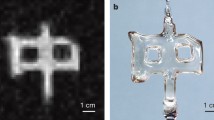Abstract
Recoilless γ-ray resonance, or the Mössbauer effect, is a well-established spectroscopic tool in materials science1. Mössbauer spectroscopy shares some of the basic characteristics of NMR (nuclear magnetic resonance) spectroscopy because both rely on nuclear resonance phenomena. A significant recent advance in the latter field is NMR imaging in biomedicine. The possibility of imaging in NMR arises because the frequency of the nuclear resonance is proportional to the local magnetic-field intensity, and, by imposing a magnetic-field gradient on the spin system, different frequency components in the spectroscopic signal are known to originate at different spatial locations within the sample. In this way, frequency information is translated into spatial information and a map of spin density may be recovered by using well-known image reconstruction algorithms. Here we propose the concept of Mössbauer imaging. In Mössbauer spectroscopy the relative velocity between the γ-ray source and the absorbing object is analogous to the NMR magnetic field. This suggests that an analogous approach to Mössbauer imaging is possible by suitably imposing a velocity gradient on the absorbing object. This can be achieved simply by rotating the absorbing object relative to the source, generating lines of constant Doppler shift (or equivalently, of constant γ-ray energy) across the object. From such measurements, a spatial map of the γ-ray absorption coefficient can be tomographically reconstructed. Spatial resolution is related to the rate of rotation of the absorber, but ultimately is signal-to-noise limited. Although there are no foreseeable applications of Mössbauer imaging in medicine, a variety of applications in materials science are expected. An experimental demonstration of the technique has been performed2.
Similar content being viewed by others
References
1. Danon, J. Lectures on the Mossbauer Effect (Gordon and Breach, New York, 1968). 2. Atzmony, U., Norton, S. J., Swartzendruber, L. J. & Bennett, L. H. Nature 330, 153-154 (1987). 3. Norton, S. J. J. Res. natn. Bur. Stand. Vol. 92, 325-334 (1987). 4. IEEE Trans. nucl. Sci. NS-21 (1974) (Special issue on image reconstruction); Comput. Biol. Med. 6 (1976) (Special issue on image reconstruction). 5. Brown, T. R., Kincaid, B. M. & Ugurbil, K. Proc. natn. Acad. Sci. U.S.A. 79,3523-3525 (1982).
Author information
Authors and Affiliations
Rights and permissions
About this article
Cite this article
Norton, S. Mössbauer imaging. Nature 330, 151–153 (1987). https://doi.org/10.1038/330151a0
Received:
Accepted:
Issue Date:
DOI: https://doi.org/10.1038/330151a0
- Springer Nature Limited
This article is cited by
-
Imaging Mössbauer spectroscopic measurements of an inhomogeneous sample
Hyperfine Interactions (1992)
-
Imaging Mössbauer spectroscopy-a new technique for materials analysis
Hyperfine Interactions (1990)
-
Mössbauer imaging: experimental result
Nature (1987)





